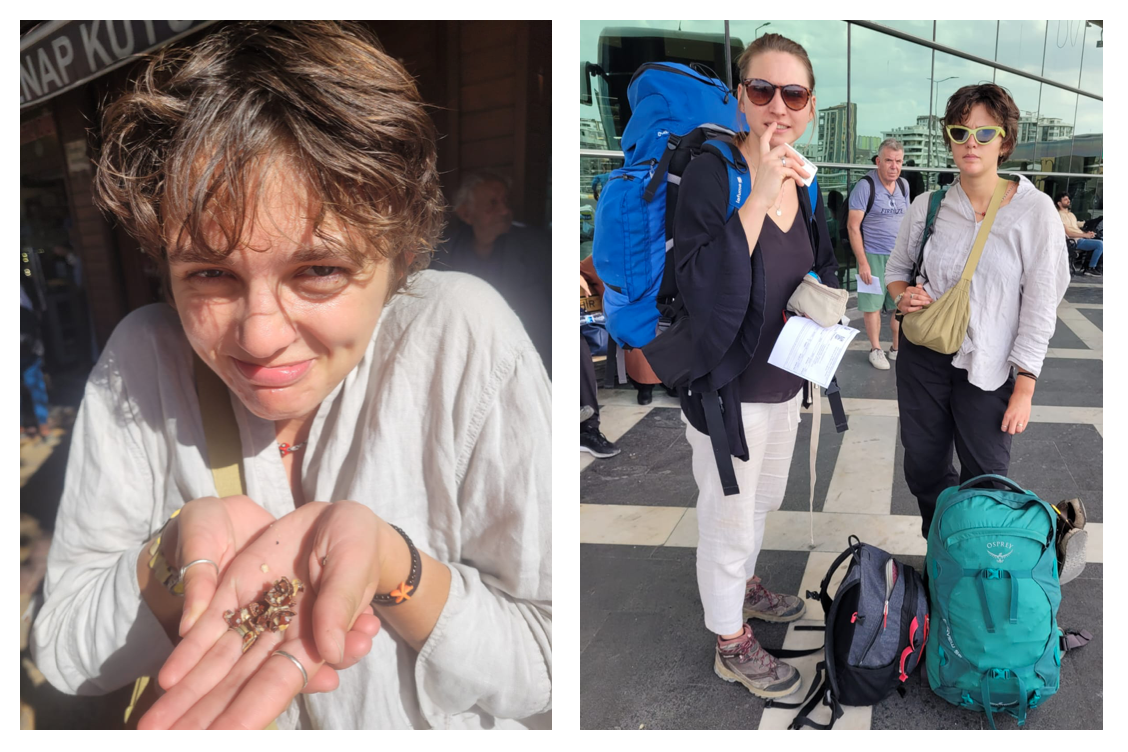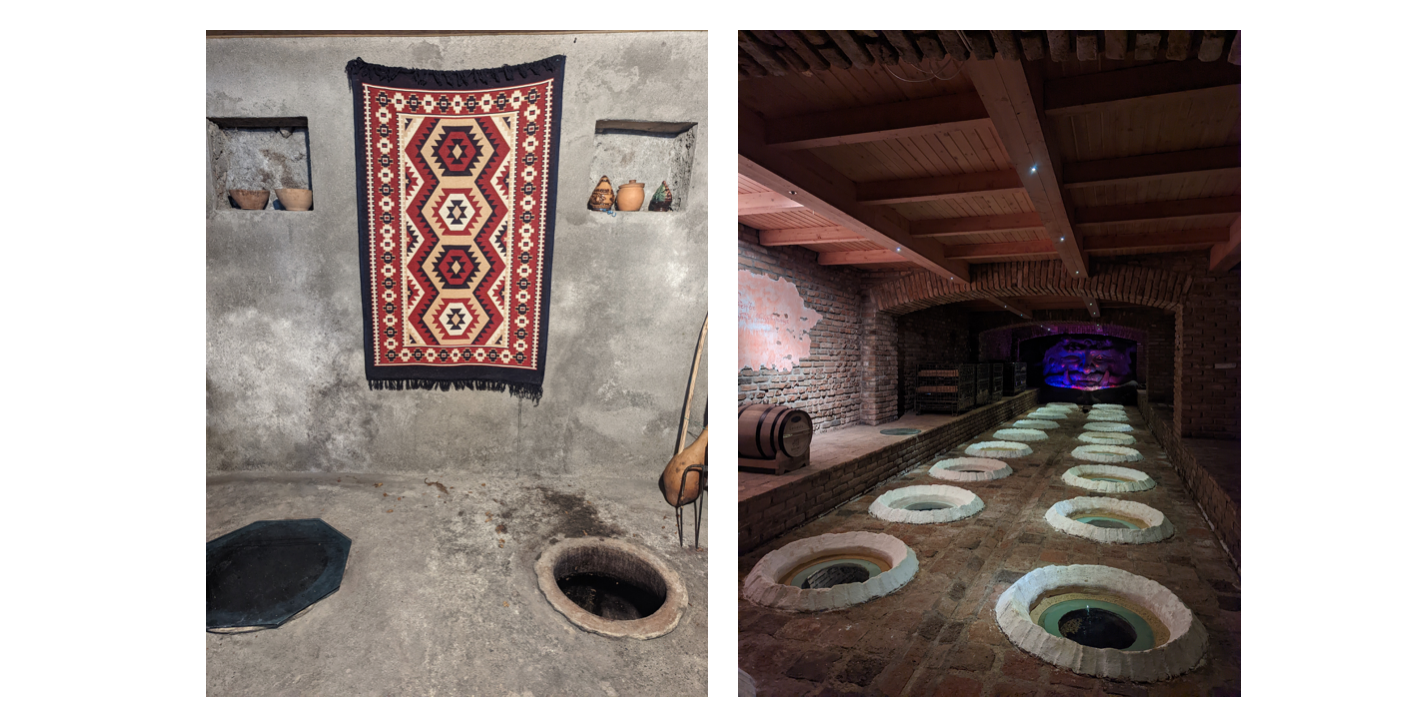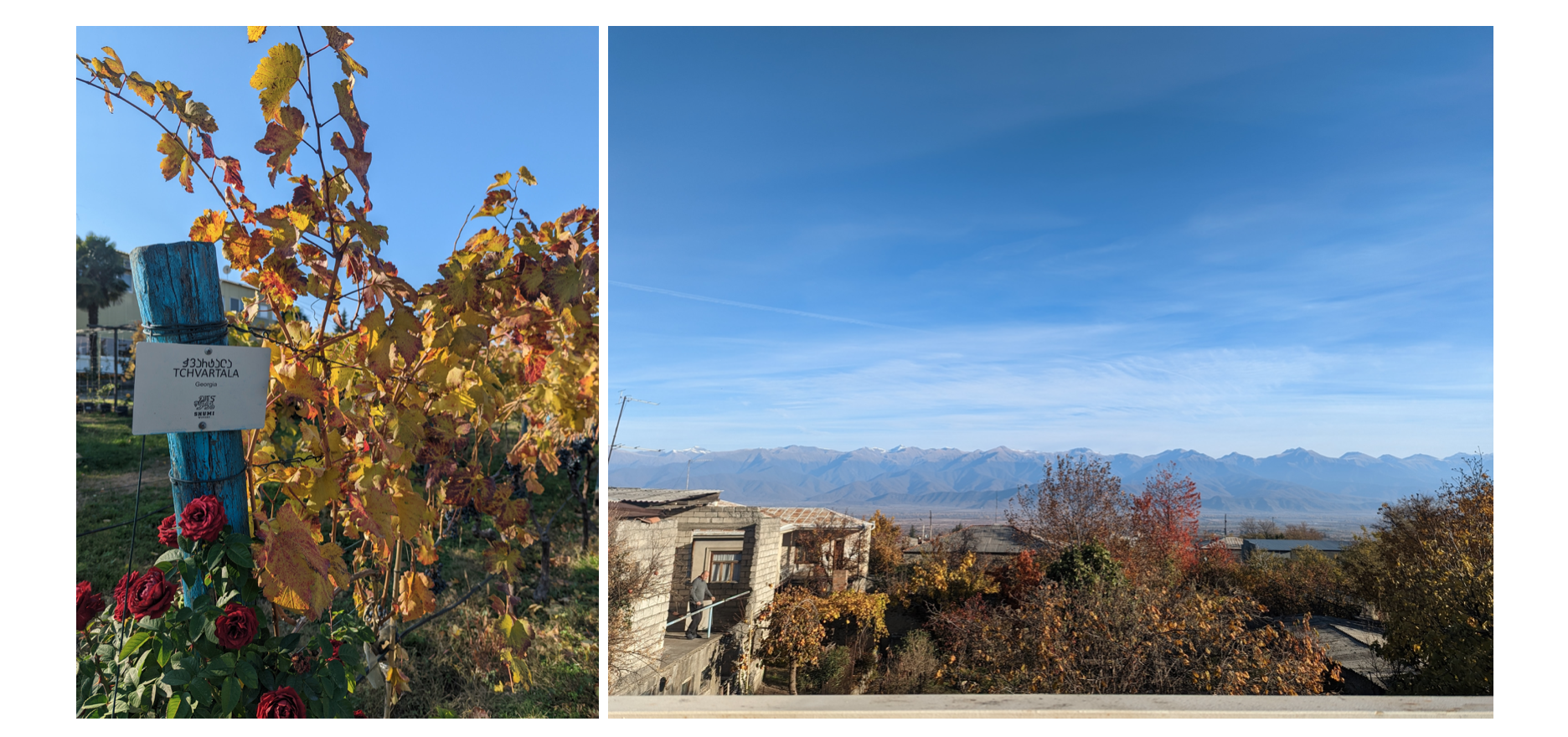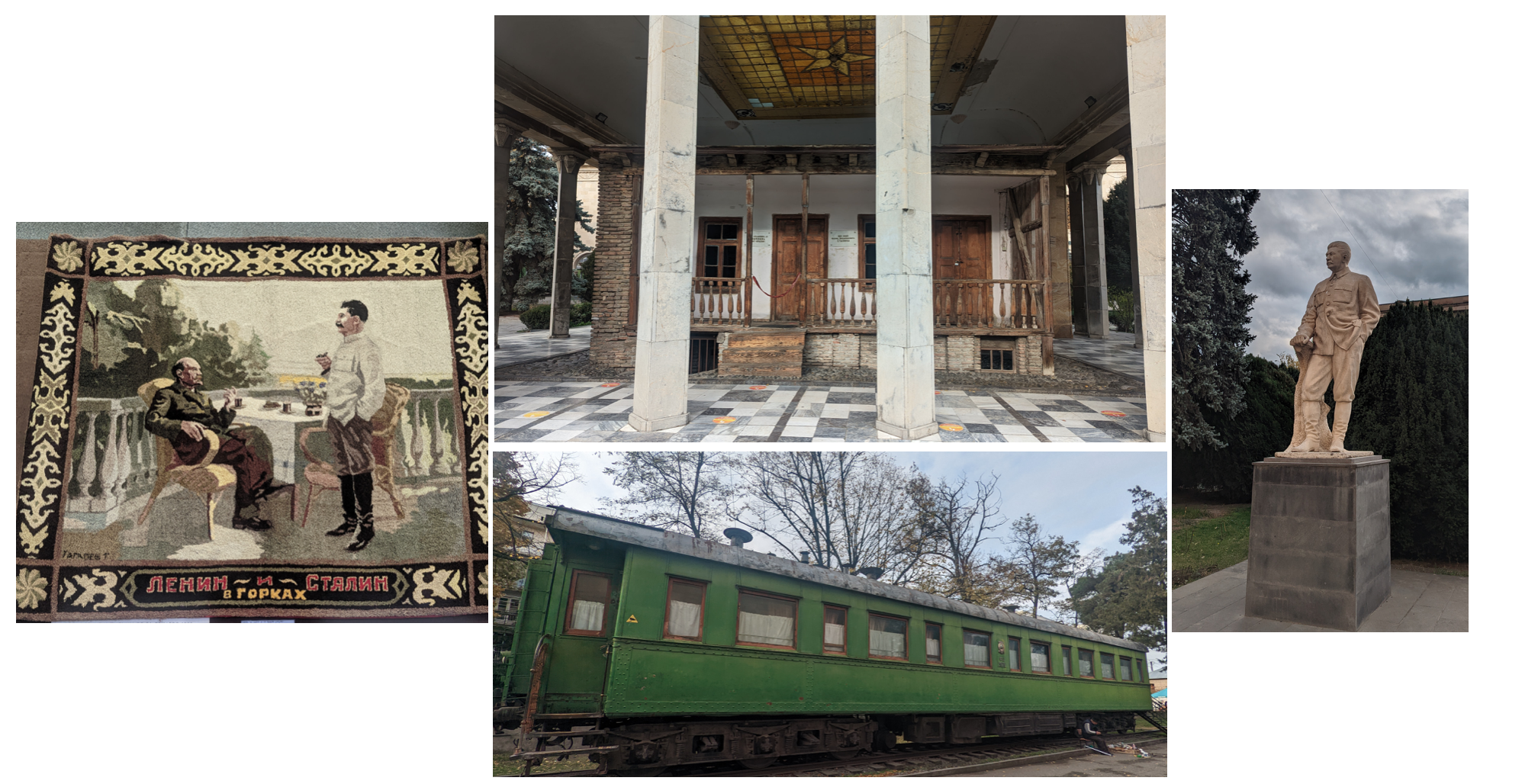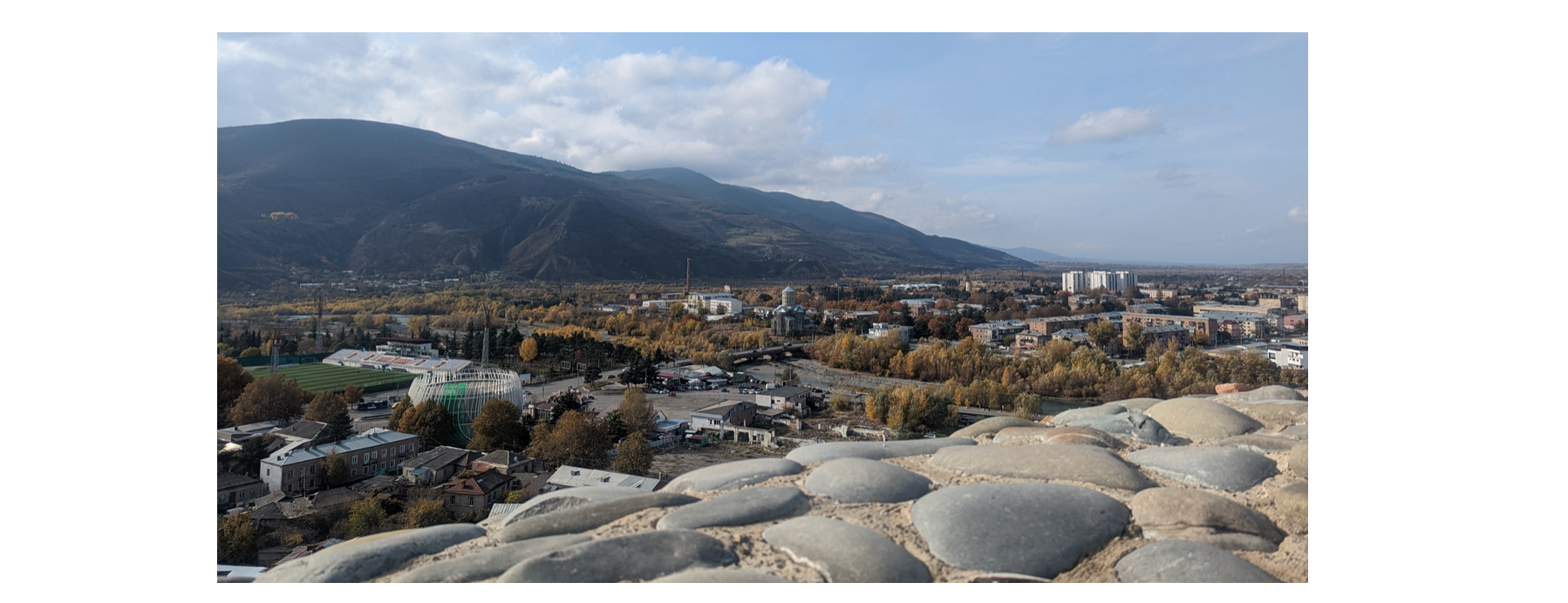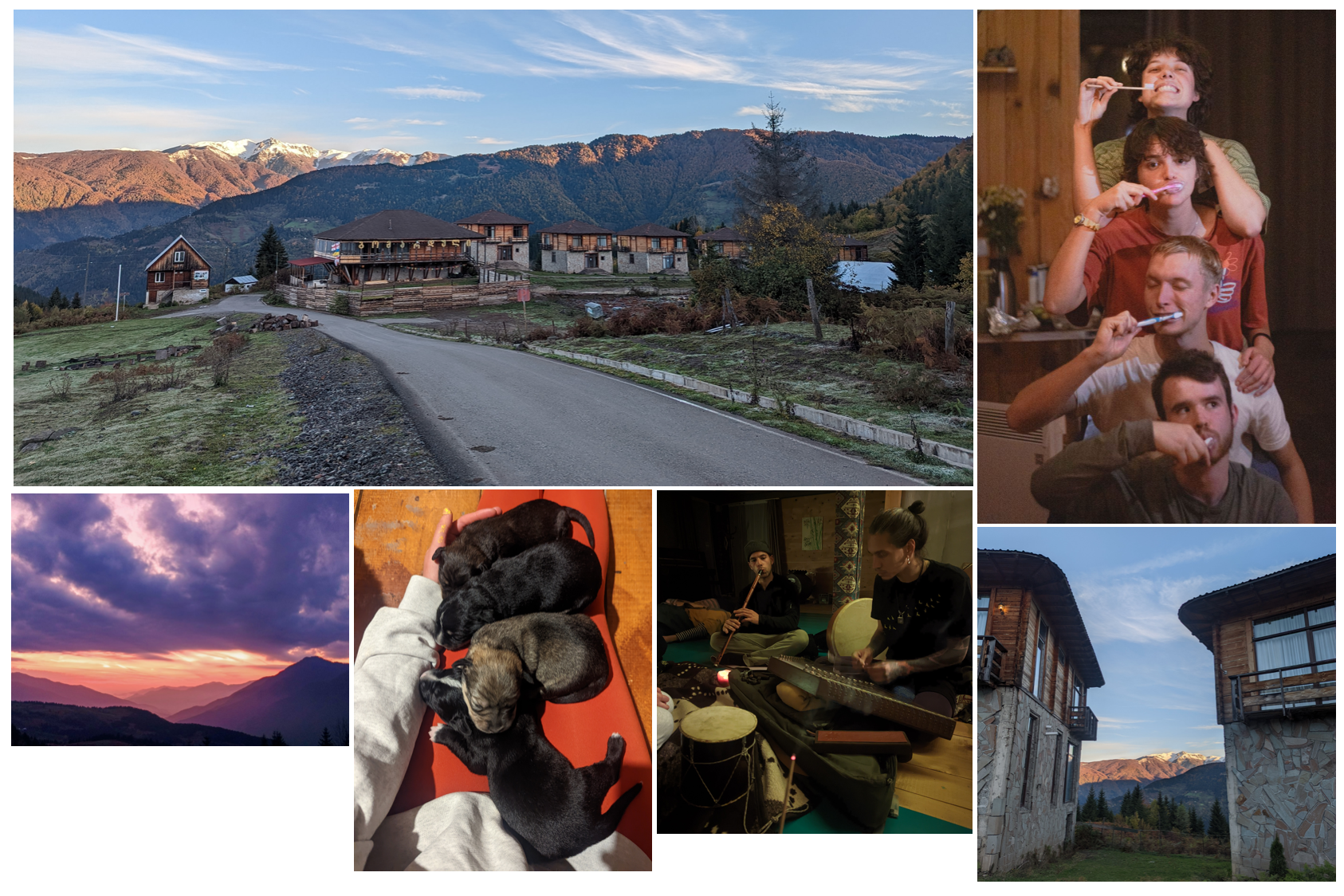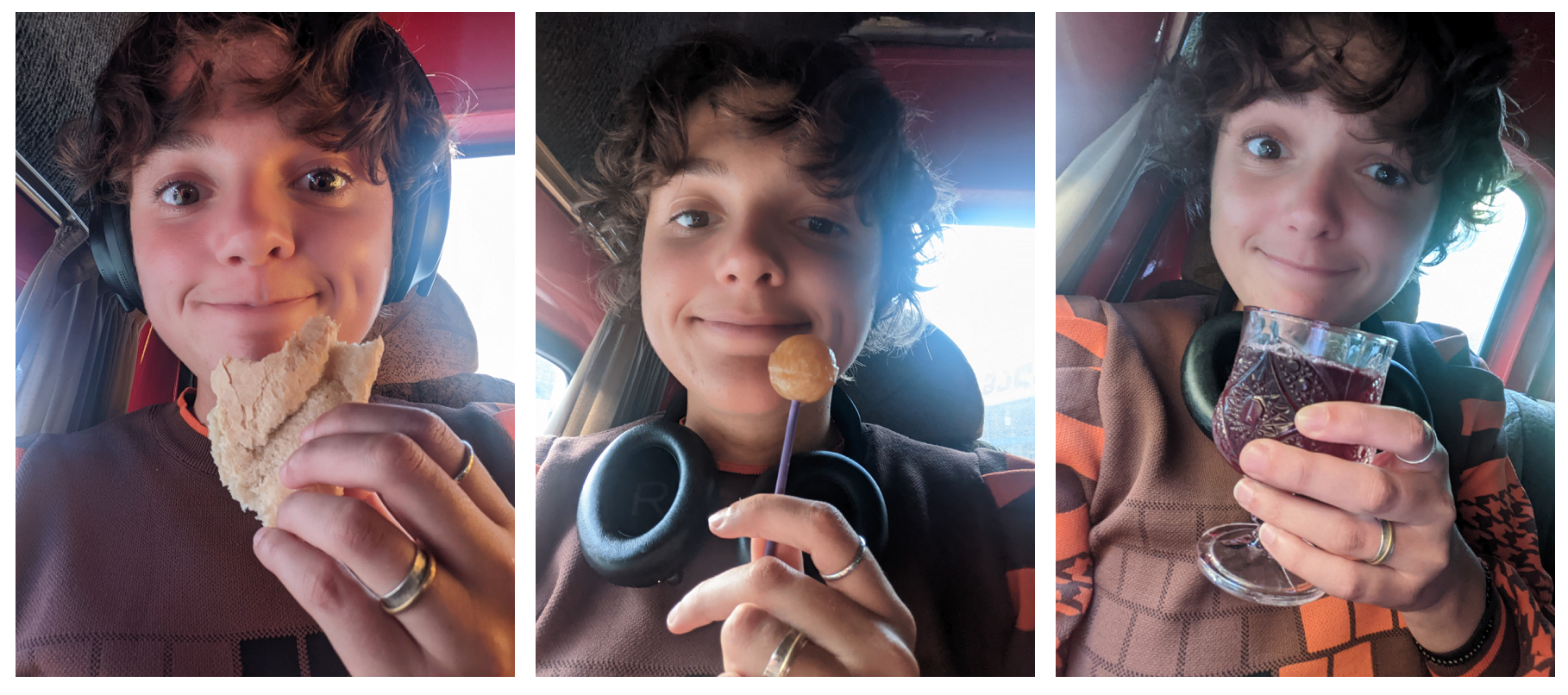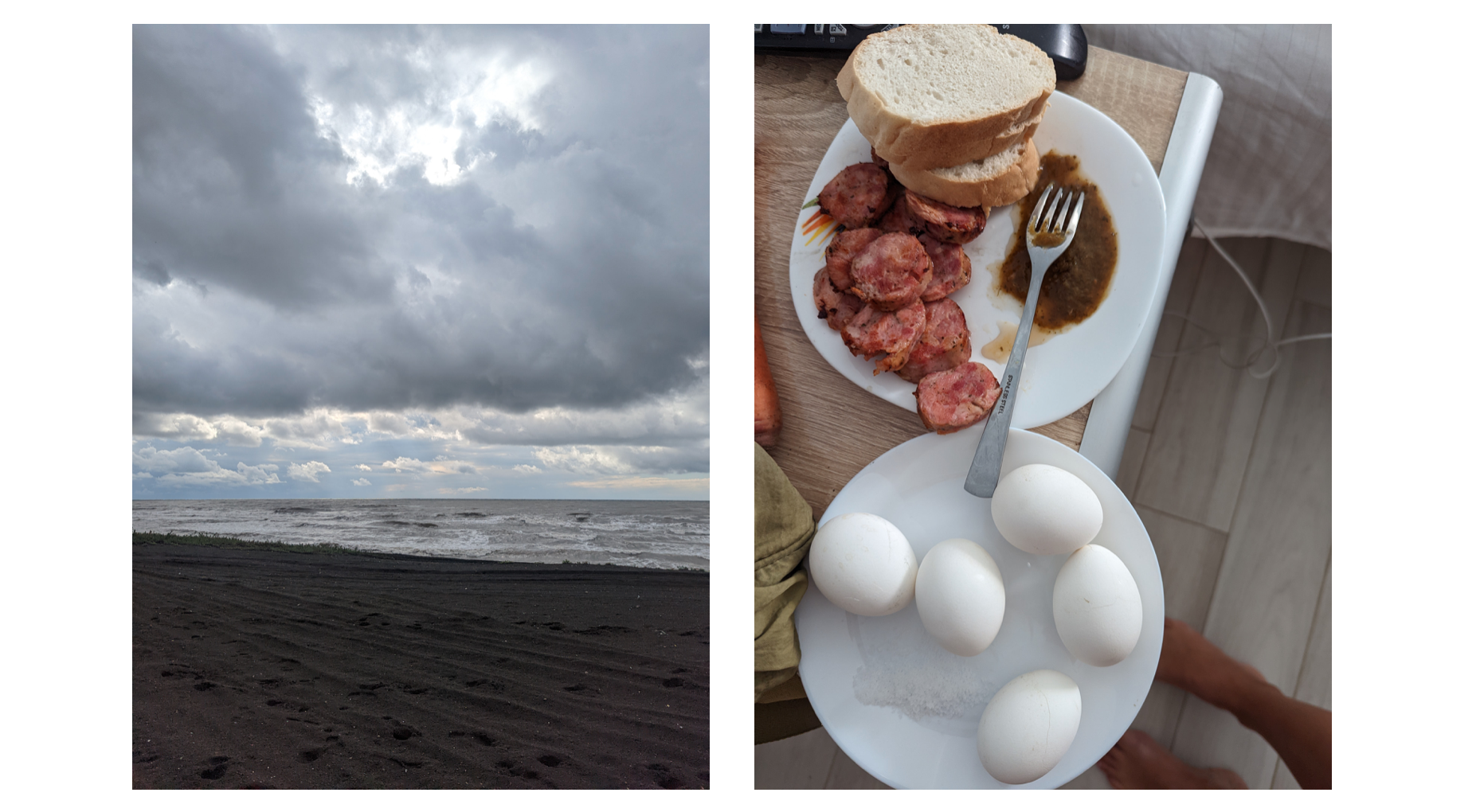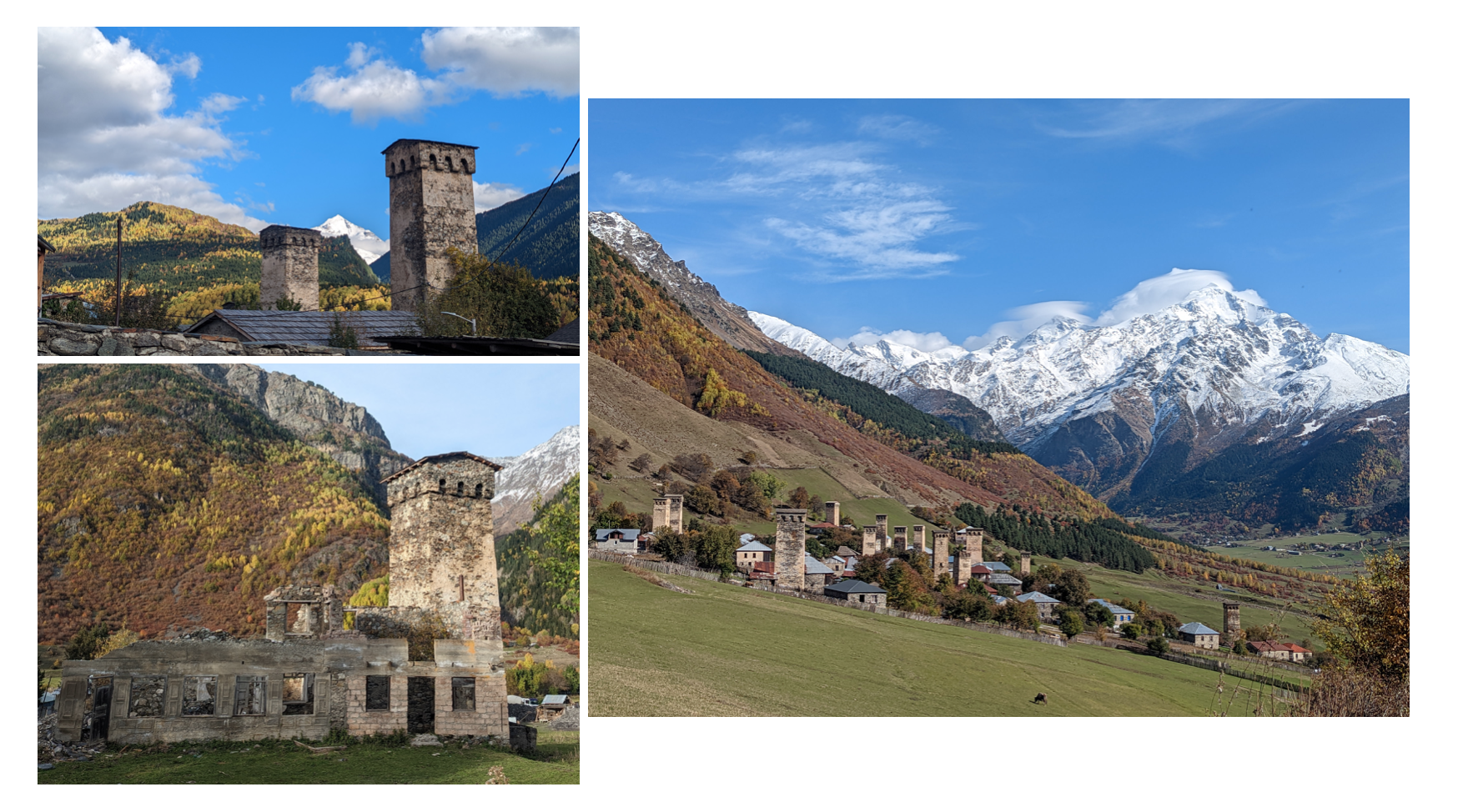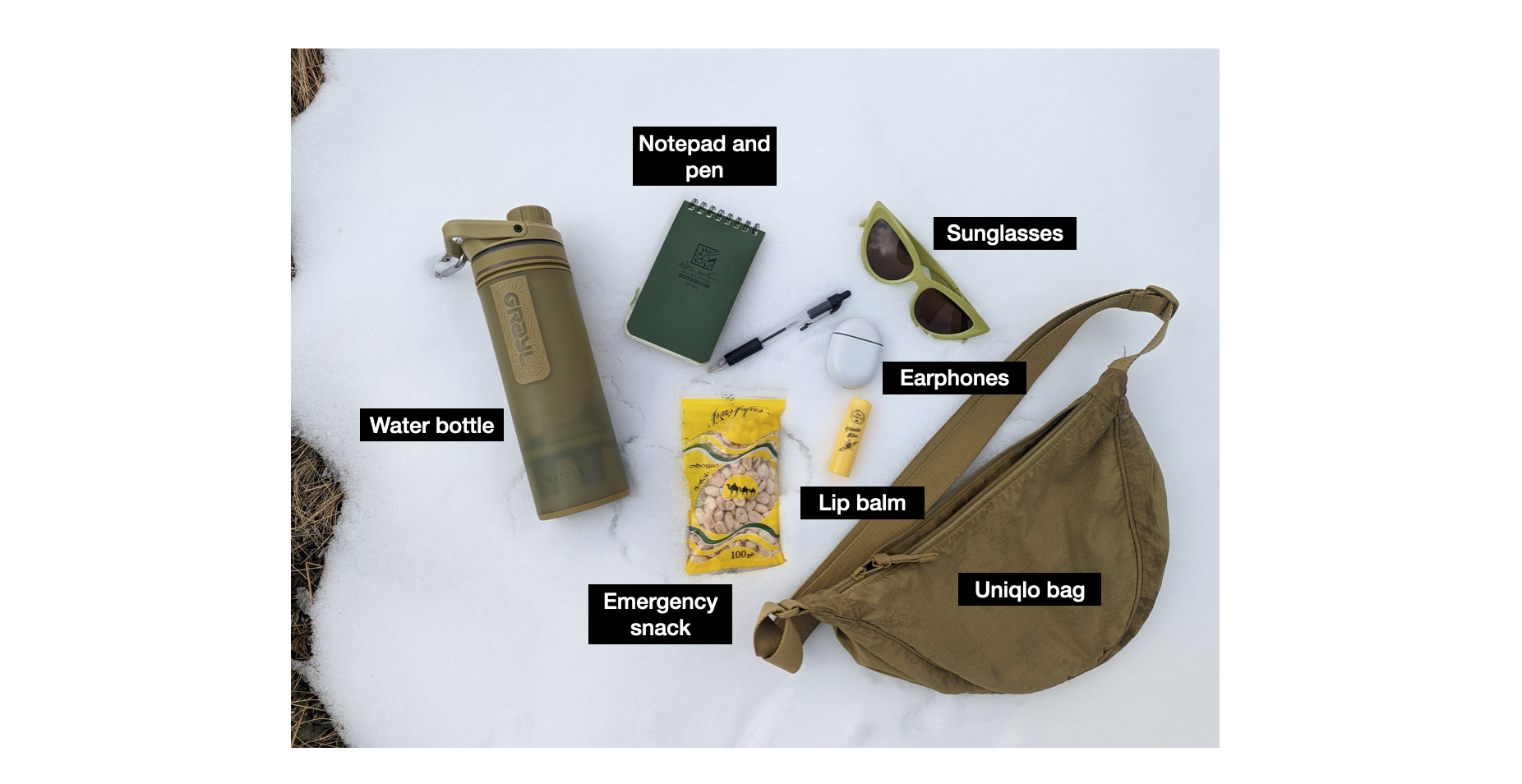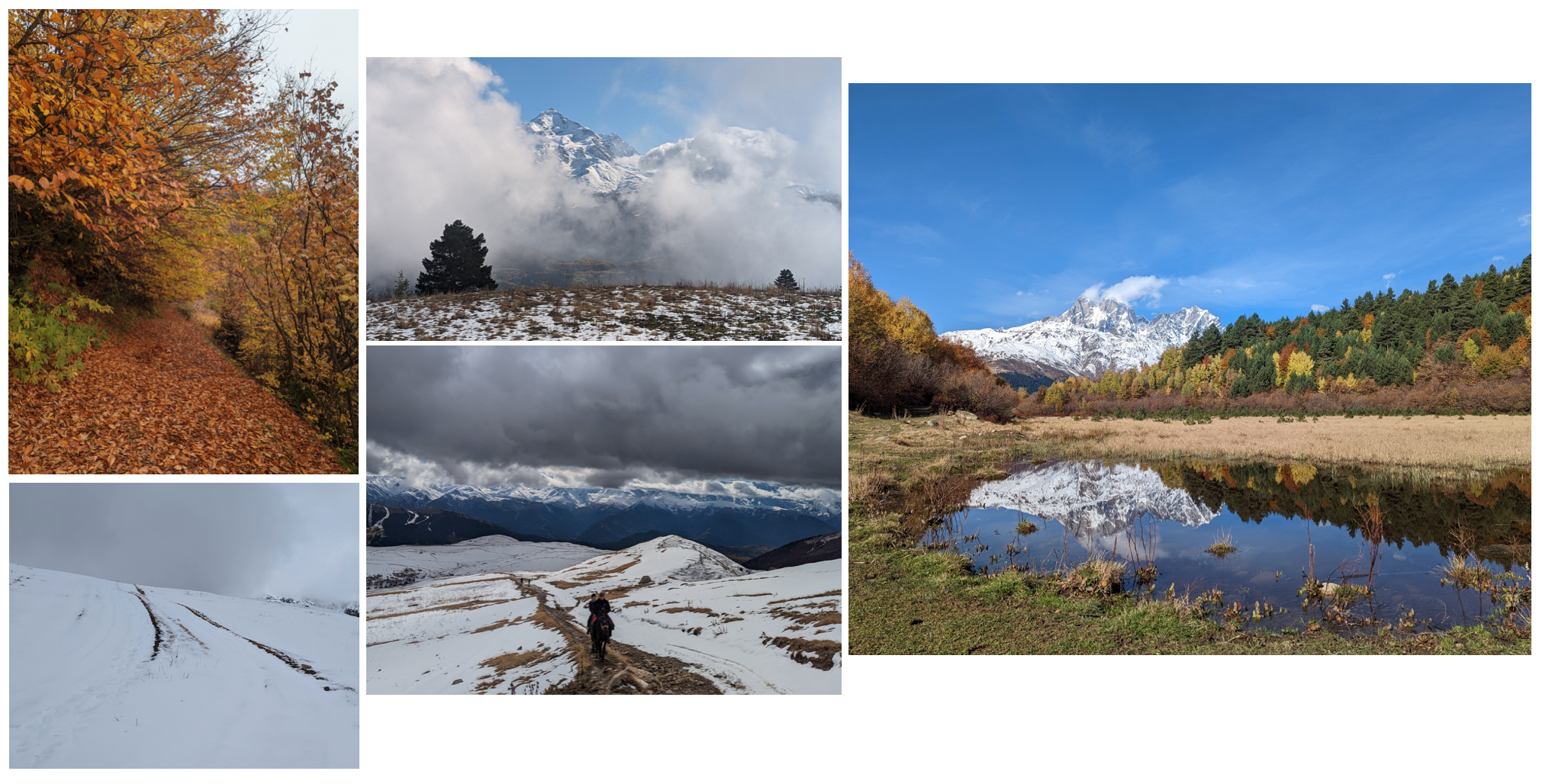When I planned my route for this year there were some countries that I really wanted to visit and was excited for, and others that were just on the way. Turkey fell into that second category. And it has made me even more grateful that I decided to do this route, because it has proven the point that sometimes the unassuming, zero expectation places can be the most wonderful. My view of Turkey before this trip wasn’t particularly positive. I saw it as a not very nice beach destination. I didn’t know anything about its culture, or food, or history. I had no idea just how rich it was in all of those areas. The people here have been unbelievable open and kind and generous. The history has been insane, with us arguably seeing some of the most important sights in human history. The food has been delightful and fun, with every place having its own specialities, especially in terms of desserts. I’ve had so many memorable experiences here. I don’t even know what to include in this post, there’s so much to say. I’m going to try and share with you some of the highlights (and lowlights of course), and attempt to communicate the essence of my experience here. It’s a place that you should visit at least once in your life. But it’s not my favourite country, I’m not in love with it, and I won’t be rushing back to it.
Our route:
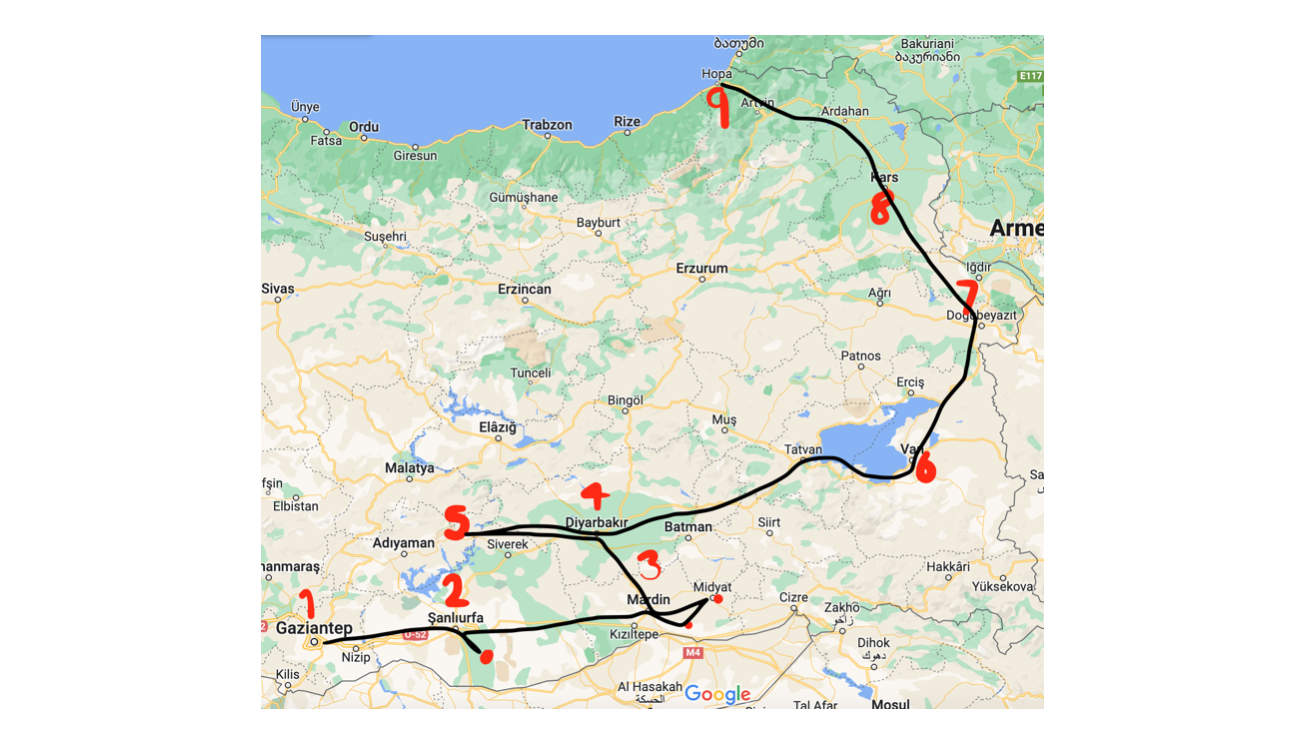
Gaziantep
This was our first stop and where I met up with Thalia and Helena. I had my own hotel room for the night which was a wonderful change from hostels. Gaziantep (or Antep as its locally known) is famous for food. It has the best Baklava in the world. It’s the major producer of pistachios so it’s also famous for any pistachio based products (which there are a lot of, you’d be surprised with how much they manage to do with one nut!). Wandering through the bazaar we saw, and sampled, all of them. Bazaars are characterised by huge barrels of products out in the open, and it’s perfectly acceptable to help yourself to these to try. I tried a fresh pistachio for the first time, peeling the soft coating to reveal the shell and then the nut, it tasted very different to dried pistachios. My favourite pistachio item was a pistachio mash sweet, it wasn’t particularly sweet but had an intense pistachio flavour. I ate a lot in my short stay in Antep, and I can confirm that the food really was incredible. Beyond eating, we visited the Mosaic museum, which is the largest in the world, and we saw the famous Gypsy Girl mosaic (which might actually not be a girl, but in fact Alexander the Great).
My favourite local interaction in Antep was with our hotel owner. He invited us to drink tea with him and asked us about our trip. In response to our answer, the google translate voice read out “freedom is beautiful”. Simple and quite funny.
Speciality dessert: Katmer. A sort of hot pancake filled with cheese and pistachios and syrup. Served with milk. (And Baklava of course!)
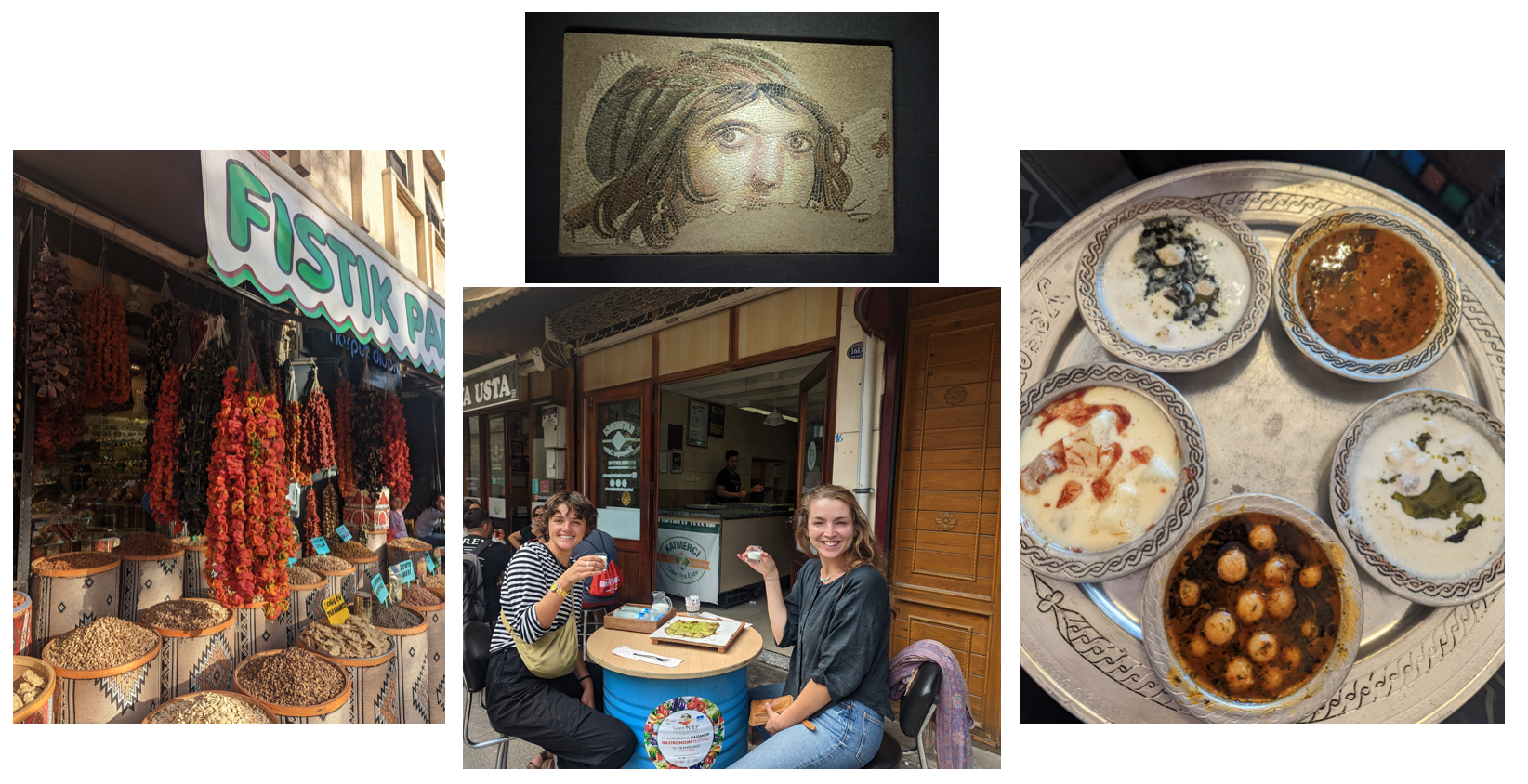
Sanliurfa
We got a taxi to the bus station in Antep, and then a bus to Sanliufa and another taxi into the centre and to our hotel (this is the procedure every time!). The taxis are interesting here, for the one in Sanliurfa the driver pulled over and three children jumped into the front seat to join us for the ride. Like Antep, Sanliurfa has a nickname which is Urfa. Our first impressions of Urfa weren’t very positive, we were stared at a lot as we walked down the main street towards to bazaar, and the dark, dirty buildings gave an oppressing feel. The bazaar was also strange and didn’t have the same happy vibe as previous ones had. This impression changed when we emerged from the bazaar into an oasis. There was a beautiful light-coloured square with a mosque, and the colours from the sunset made it glow. We placed our headscarfs on and entered the mosque, ready to see an important religious site: the cave where the prophet Abraham was born and lived for the first 15 years of his life. It was quite impressive, and very strange. People washed their hands in the ‘holy’ water from the taps and wet their faces with it. Close by we came across a beautiful park, with a small lake and a river that led to a larger lake. These were filled with fish (carp we found out). They lakes also had religious significance, with the larger one having supposedly formed when King Nimrod burned Abraham alive at the location, and the smaller one when he did the same to his daughter who was Abraham’s fiance.
On our second visit to the bazaar we enjoyed it a lot more. We drank pistachio coffee (remember what I said about them making all sorts from it!) in the big square in the centre of the madness, and enjoyed food in a little shop much to the man’s excitement. We watched as he called over his friends from across the bazaar to see the three women in his shop. He even asked for a photo of us with the sheep head stew.
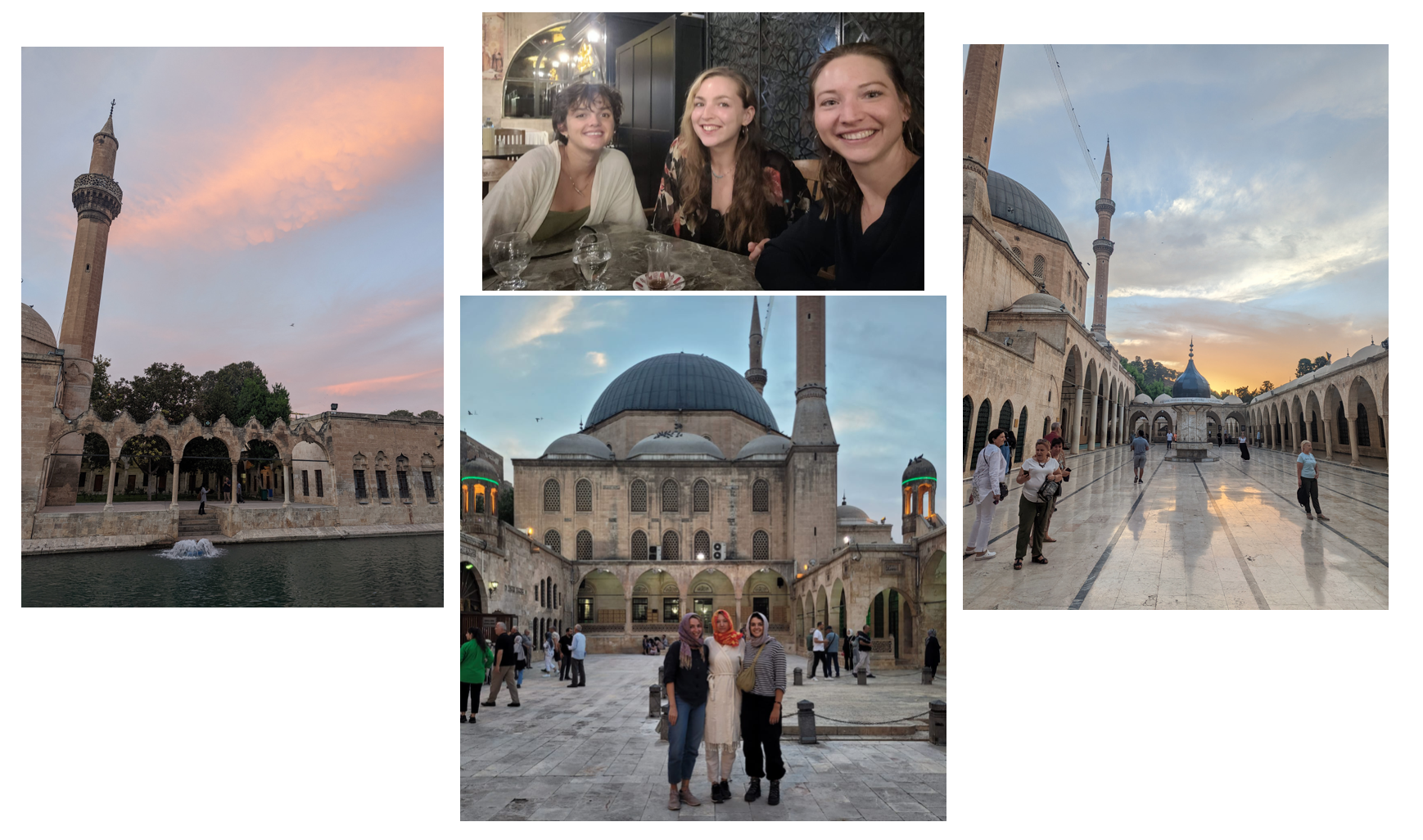
Gobeklitepe
The reason we’d come to Urfa was to see Gobeklitepe. Now this place is historically insane. It is the oldest religious site in the world, by 6,000 years! When it was discovered in 1994 it changed our entire understanding of human evolution and history. Until Gobeklitepe it was thought that agriculture led to civilisations which led to religion. But Gobeklitepe, a religious site, was built before farming and agriculture began, turning this idea on its head. Instead, it suggests that religion led to civilisation, which in turn led to agriculture. I’m not fully convinced by this explanation however. I struggle to follow the logic that a huge group of people settled in one place knowing they couldn’t sustain themselves with their current lifestyle, to build a large religious structure, with the apparent hope that they would find some way to sustain themselves. I find it hard to believe they would attempt this without any knowledge of a potential way to sustain themselves, and for them to be so lucky as to stumble across farming and for it to work - with crops not yet being domesticated. But anyway, the site is incredibly important in human history and a bit mysterious, with the prehistoric people burying the site and leaving 1,000 years after construction began. As of 2021, less than 5% of Gobeklitepe has been discovered, so maybe more clarity will come. The site is 20km away from the city, and we got a taxi there and managed to hitchhike back. In the city there is the Sanliurfa Archeological Museum which gives wider context to Gobeklitepe and the region in general, it was a really well done museum.
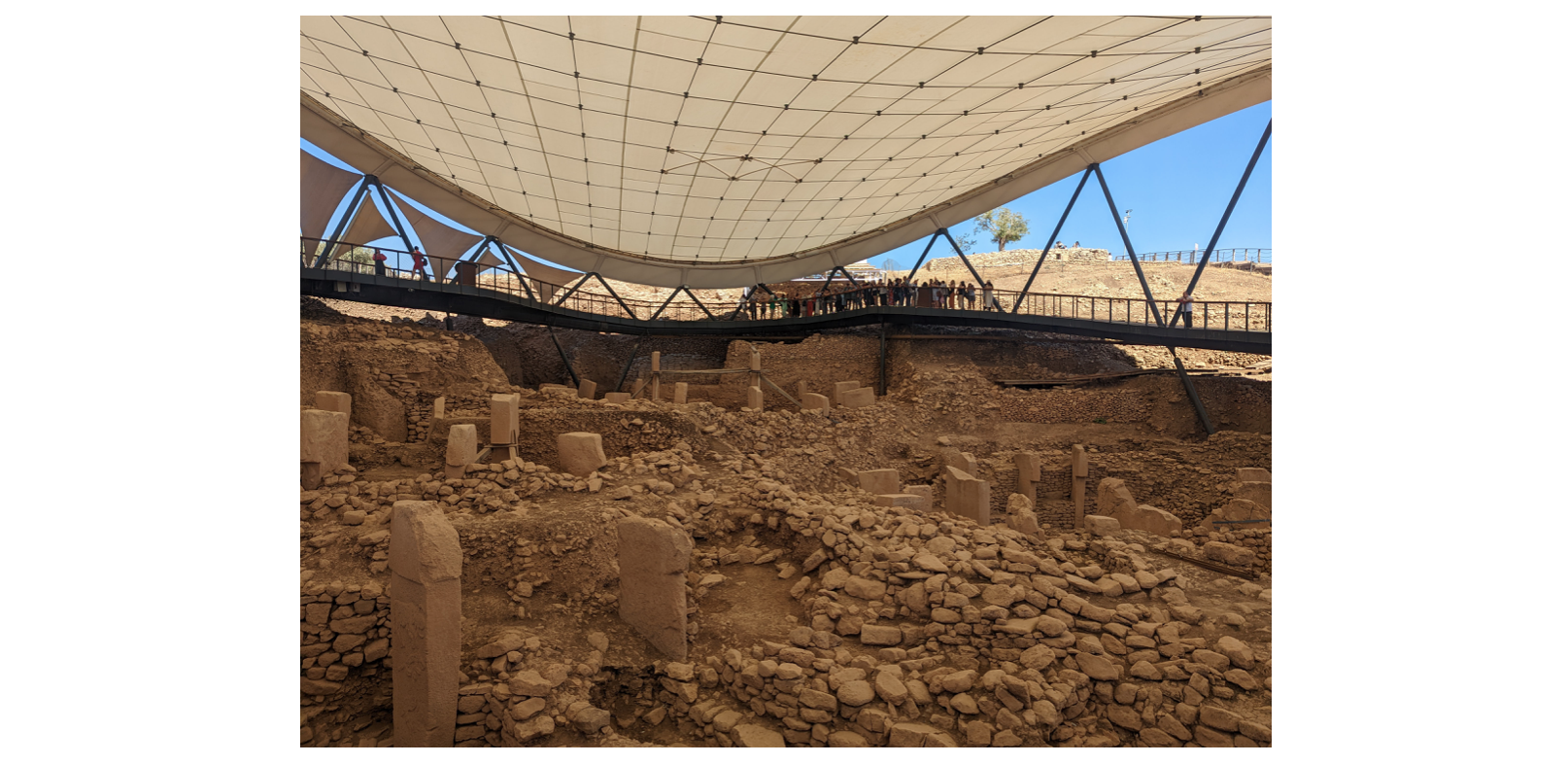
Harran
Harran is another site of interest near to Urfa, and we got a taxi here. It’s a small town close to the Syrian border, where there are still traditional beehive mud houses. The houses were very interesting, but the overall experience wasn’t great. We were hassled a lot by men who wanted to be our ‘tour guides’. The town was clearly very poor, filled with Syrian refugees, so we understood the men’s desperation but it was quite aggressive. It was a very hot day, and the environment was so dry and like a wasteland. Our taxi driver tried to rip us off as well, so all in all it was a bit of an ordeal! In a dramatic change of vibe, back in Urfa we spent the evening at a traditional music and dinner night. It was a really wonderful evening. The music was great, the food was plentiful and delicious (salad with dips, soup, köfte and stuffed dried vegetables, kebab, Çiğ köfte (ceremoniously made), kunefe. And ayran (a salty yogurt drink) and lots of tea. The Çiğ köfte was made in front of everyone by the chef, with him kneading the bulgur, spices and raw meat together, alongside the music and dancing. We joined in with the dancing of course.

Speciality dessert: Şıllık. A crepe-like pancake filled with cheese and pistachios, served cold and drenched in syrup. I was not a fan!
Mardin
Our bus to Mardin from Urfa was late and took an extra hour which meant we arrived quite late into the city. We were all feeling exhausted when we got to our hotel, so the news that there was an issue with the room we’d booked and they needed to add an extra bed to a different room for us (delivered through google translate which added to the confusion) was not happily received. As we sat waiting, we witnessed a whole bed being pulled up from the downstairs courtyard, and wedged into the room. It was quite comical. Our first impressions of Mardin were that it was a lot more touristy than Urfa, albeit Turkish tourists. But this still meant it felt less conservative and we got stared at a lot less. The old town has one big main street which cars can drive down in one direction, and lots of narrow streets with steps branching off. There are no cars on these, but several horses and donkeys ladled with goods. The buildings are all made from the same light coloured limestone. We visited an orthodox church, a protestant church and a mosque. It was interesting to compare the vibe from all of them. They all feel very similar to me. A lot of the stores in the bazaar were closed but it was, as always, fun to wander around it. It felt a lot more touristy than the previous bazaars. The stand out products were blue sugared almonds and soap. There were also a lot of bakeries selling walnut biscuits which we learnt are a Syrian food. The other major product from Mardin is wine. Up until this point we hadn’t seen any alcohol at all in the East, so it was quite exciting to see all of the wine shops. One evening we went into one to try them. They are Assyrian wine, and they didn’t taste at all like the wine I was familiar with. The reds were very fruity and heavily spiced, reminding me more of mulled wine. The owner, Baris, told us lots of information about the wines. While sampling them, a friend of Baris came in and joined us. He was called Ufuk and he offered to show us around the following day. The following morning we decided that we had all got good vibes from him so took him up on his offer. Ufuk picked us up and we were all shocked by the car - a very fancy blue one with a red stripe, it was a Dodge. We drove first to Dara (stopping briefly at a monastery on the way), a town with an underground city carved into the rock. Sadly, it was closed! Ufuk had an idea however, and we set off to Midyat. The drive took us right along the Syrian border. It was a strange experience driving in the fancy Dodge, listening to heat waves by glass animals, looking out the window and seeing the barbed wire of the Syrian border. We stopped at a place for lunch which was right on the river, with the tables built over it meaning you could sit with your feet dangling in the water and see the water flowing underneath you. Ufuk paid for everything and refused any discussion about allowing us to pay (I’ve noticed this a lot in Turkey, it’s almost seen as offensive if you try and argue). We continued to Midyat, a smaller, slightly prettier town than Mardin. Back in Mardin we returned to the wine shop, reflecting on how yesterday evening we would never have guessed how the following day would unfold and that we’d be back to the same wine shop. We went out for tea with Baris and Ufuk, I quite like how this is their version of going out for a beer in the evening. We walked back to our hotel and observed Ufuk deal with the police over a ‘small issue’ (something to do with his younger brother driving his car). Ufuk and Baris were both so lovely and I can’t thank them enough for showing us around Mardin and the local area!
Felix, Thalia and Helena’s friend from a workaway earlier in the summer, joined us on our last day in Mardin. He was travelling with a van and from this point we all travelled together in this (so no more buses or taxis in Turkey from this point!).
Speciality dessert: Blue, sugared almonds.
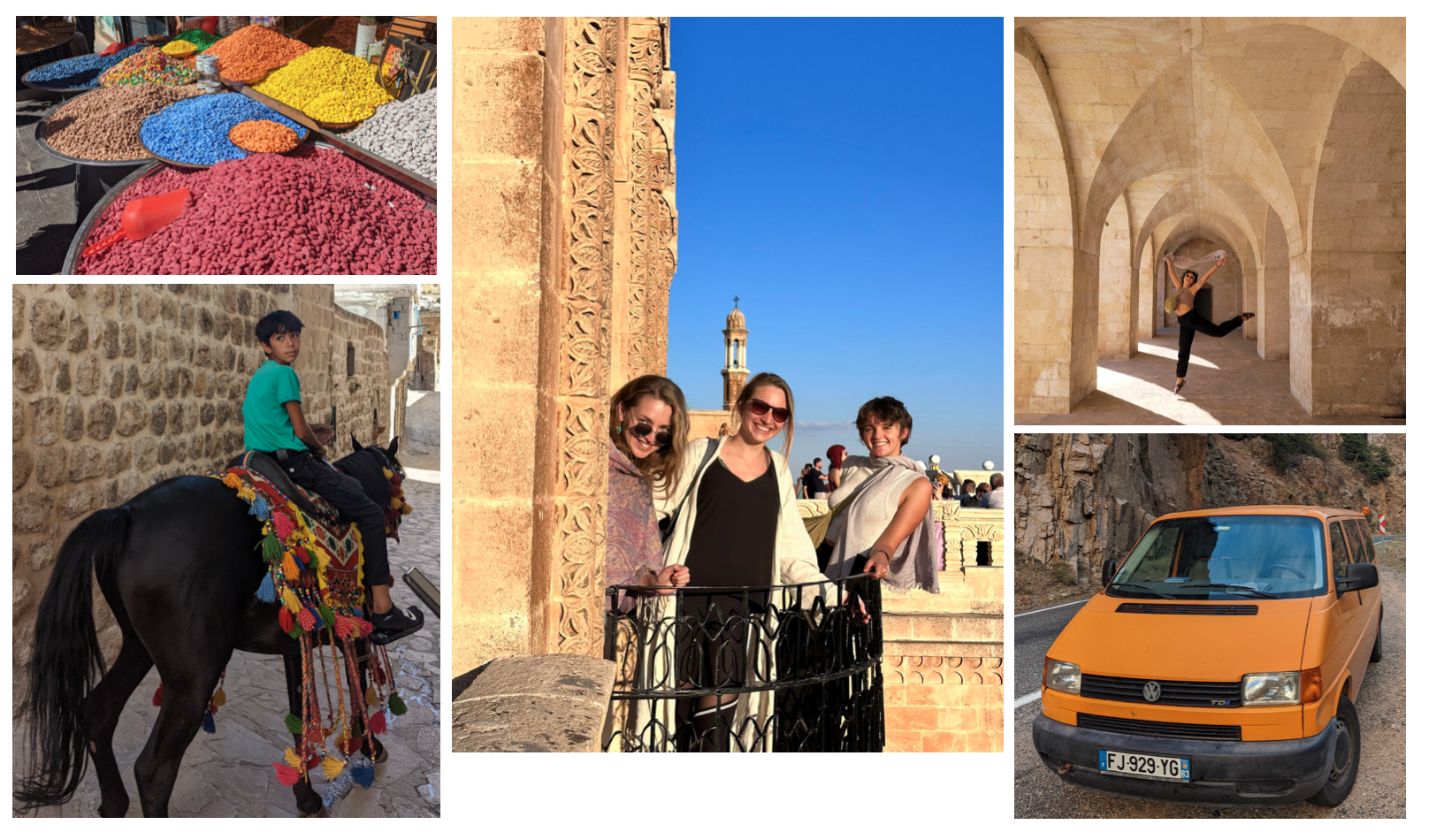
Diyarbakir
This city also had one main street which reminded me more of Urfa than Mardin (also because we were stared at a lot again). It had huge city walls which we climbed up and admired the rural view on the other side. Along the main street were several Hans, these are remnants of the city’s location on the Silk Road (the ancient network of trade routes across Eurasia) and are large quads with two floors. The bottom floor would be for the animals and for stalls and restaurants. The top floor would be for rooms, for the travellers and traders to sleep in. The main mosque was built with dark bricks which gave it a very oppressive feel. We walked out to the Dicle bridge which was a very large, stone bridge. The scenery was pretty, very rural feeling despite us being just a 40 minute walk from the city centre. There was a wedding party dancing on the bridge with loud music and drums. One of the women beckoned for me to join them so I did, putting my dancing practice in Urfa to good use! If you google Diyarbakir you might see results claiming it’s unsafe, due to clashes between the PKK and the Turkish Government. We didn’t see any of this. The PKK are the Kurdistan Workers’ Party. Diyarbakir is the de facto capital of Kurdistan, and hosts the largest Kurdish population in Turkey. The Kurdish conflict in Turkey is deep-rooted and complex, as seems to always be the case with ethnic issues like this. I’m not well enough educated on the issues to talk about them here, only having a vague understanding myself. I wish I had had the time to look properly into the conflict while I was here, but it’s difficult to juggle researching the ancient history, modern history, culture, food of a place, and enjoying actually being there! Some things get left behind, and sadly the Kurdish conflict was one of these for me.
We weren’t staying in a hotel in Diyarbakir, instead a friend of someone Helena knew had kindly offered us their empty apartment to stay in. It was a little outside the city, in a big flat block alongside many other identical ones, with plots of rubble where it seemed like additional blocks would soon be built. The apartment was very swanky, clearly very new. We had a wonderful few days relaxing here, fully enjoying being in a house rather than a hotel/hostel. We cooked dinner, we watched a movie, we worked out. We spent one whole day just hanging out there, something I hadn’t done for months and really enjoyed. My favourite activity was chocolate tasting. Helena has a PhD in chocolate (the genetics and chemical characterisation of flavour in cocoa to be more specific) so gave us a full chocolate tasting lesson. Before we left the comfort of the house, we cooked breakfast for the owner’s cousin who had brought us over the keys, to say thank you. It was fun to make a Turkish breakfast after eating so many, although we added our own twist, with banana oat pancakes making their way to the table.
Speciality dessert: Kadayif. Shredded-wheat-like crunchy casing around pistachio mush, with syrup, served hot. My favourite dessert so far, huge fan.

Mount Nemrut
We drove two hours to a little village called Karadut, at the base of Mount Nemrut. We were planning to go up the mountain for sunset, so spent the afternoon exploring the village and discovering just how tiny it was. Whilst we were out wandering, it started to rain, and then to really rain, so we took shelter in an empty garage. An old man rode past on a donkey and then came in to join us, picking up breezeblocks for us to sit on and making conversation. Sat on the breezeblock, eating a pomegranate handed to me by a farmer earlier, watching the torrential rain, surrounded by friends and chatting to an old, very well-dressed Turkish man, I thought to myself how magical travelling is. Just before sunset we drove up the mountain, walking the final part up to the reason we’d decided to come here. On top of this mountain there are several huge statues which have been decapitated, their heads lying on the ground by their feet, on both the East and West side. The giant heads and headless bodies were really cool, but the experience was negated by the huge number of people up there, and how cold and windy it was. Behind the statues was a huge, man-made pile of stones, purportedly a burial mound of King Antiochus I, although the tomb hasn’t been found. On our walk back down the stormy sky became even more dramatic, with one cloud so black it seemed endless. The guesthouse we were staying at provided dinner and we enjoyed the most succulent chicken I’ve ever eaten. The power went out halfway through dinner, so the staff shined their phone lights on us. We spent the rest of the evening playing cards, playing guitar and chatting by gaslight, with the power coming on and going back off repeatedly.
Mount Nemrut was meant to be our final destination as a four, but happily the others became convinced to continue with me to Van! I’d take the credit for this but I think it was more the draw of Van than anything I said.
The drive from Mount Nemrut to Van was a long one, 530km. We shared the driving between us, which I loved as I’d missed driving the van at home. There were four or five military checkpoints where we had to show our passports. We didn’t have any issues with them on this drive (despite Helena, Thalia and Felix all having stayed longer than the allowed 90 days…) and often left the guards laughing in bewilderment at one Swiss, one Belgian, one English and one French person driving in a yellow van.
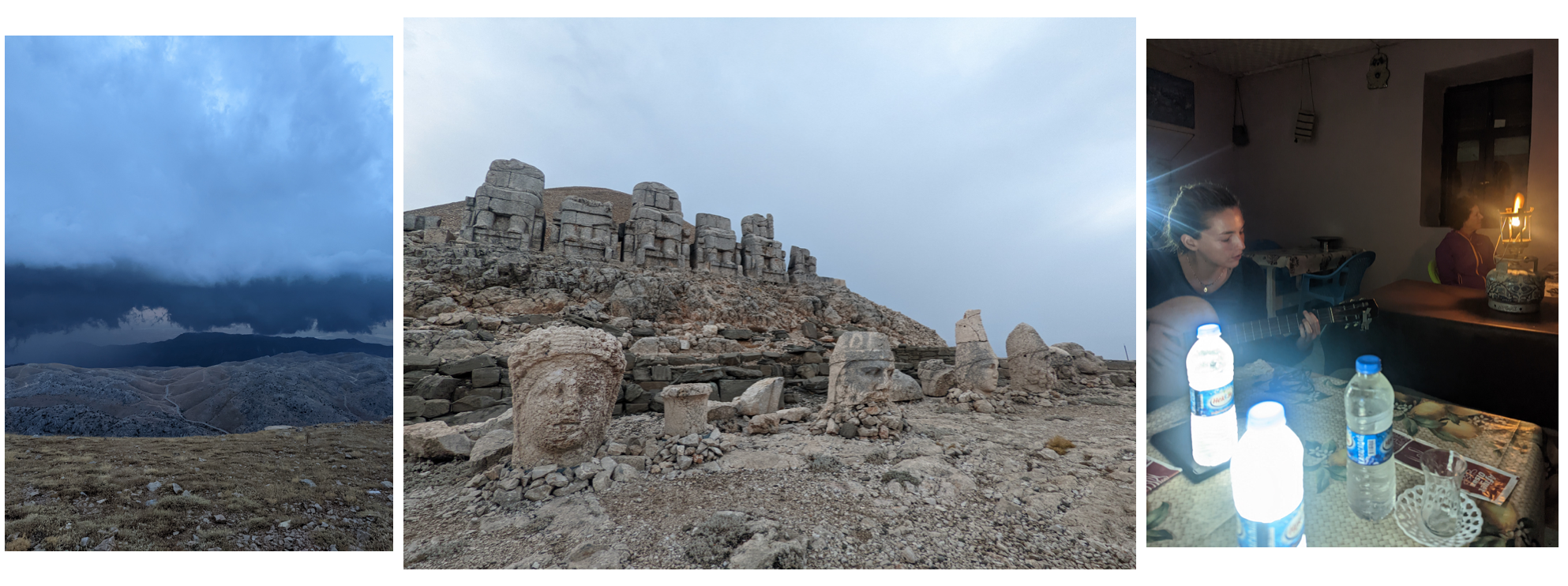
Van
Van was a larger, more bustling and modern city. This meant it was uglier than previous ones, but it had a bigger selection of shops, cafes and restaurants. It’s on the largest lake in Turkey. It has a castle in ruins which was quite cool, with a good view of the lake from the top. The lake has a little island in it called Akdamar Island. We took a ferry out to this and saw the Armenian church it’s home to. I also saw several tortoises and rabbits. One of the most famous things about Van is the Van cat. This is a special breed of cat which is white with one blue eye and one green eye. We went to the Van Cat House to see them, and it was really strange. Hundreds of white cats in one room, jumping on us and meowing, it could’ve been out of a horror film and I love cats! The lake itself wasn’t that special, by the city it was a bit industrial seeming and not very clean.
Thalia flew back to Switzerland after Van sadly, leaving Helena, Felix and I to continue.
Speciality: The Van breakfast. Just a Turkish breakfast with a few added dishes. But you have to ask yourself, at what point does a breakfast have too many little dishes? I’d argue the ordinary Turkish breakfast has already reached this limit…
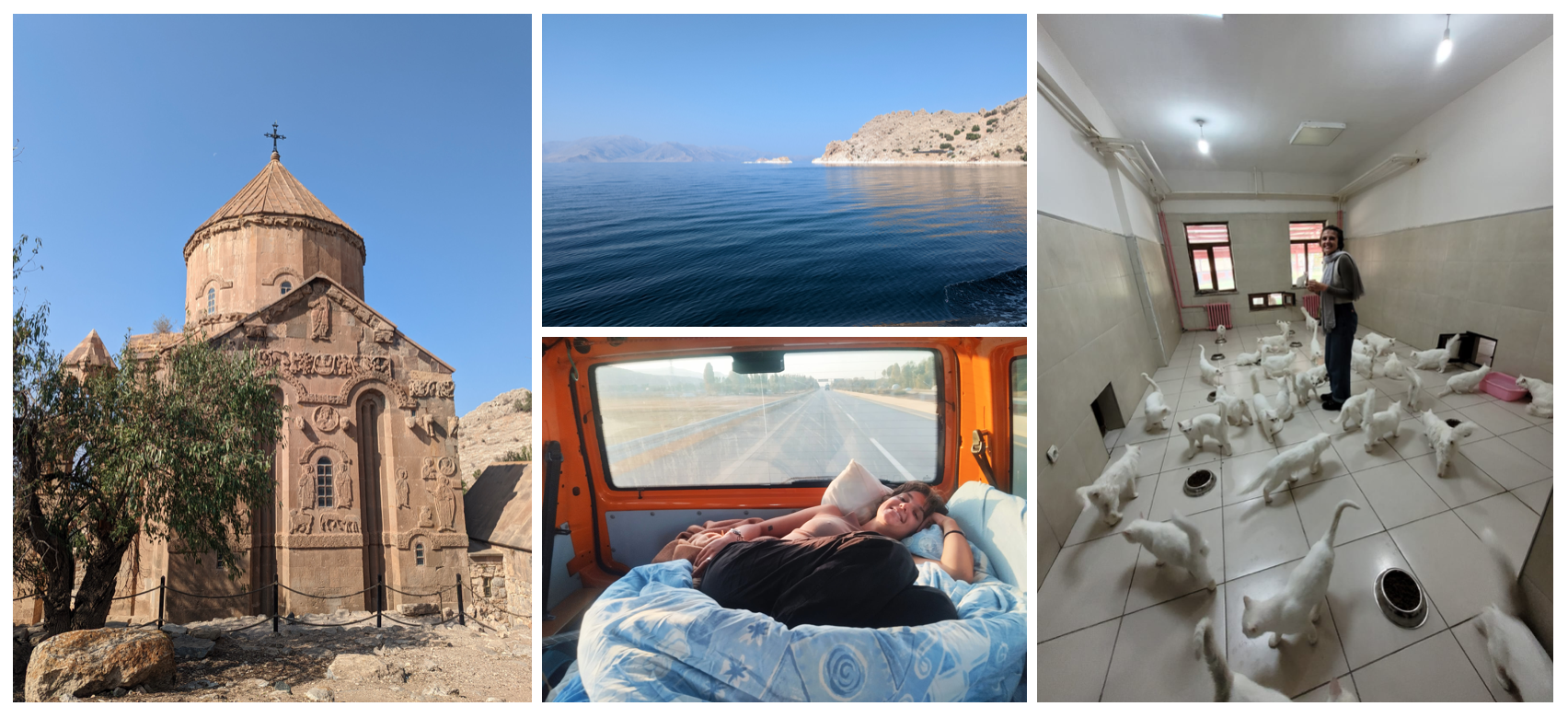
Dogubeyazit
By far my least favourite city. Again, just one main street but this one felt equally oppressive and depressing. There’s always more men walking around than women, but I really noticed it here. Luckily we were only there for one night, and we were really there to see the Ishak Pasha Palace just outside the city. Now this was beautiful. An open style palace made of sand coloured stone, which sat so perfectly against the red mountains, and was lit up by the setting sun. Lots of intricate details had been carved into the stone, and the maze of rooms had wonderful details like fireplaces, interesting windows and pillars. It hosts a blend of Ottoman, Persian and Armenian architecture. From the palace you had a view of Mount Ararat (although it was almost entirely covered by clouds when we were there), this is the highest peak in Turkey and the supposed resting place of Noah’s Ark.
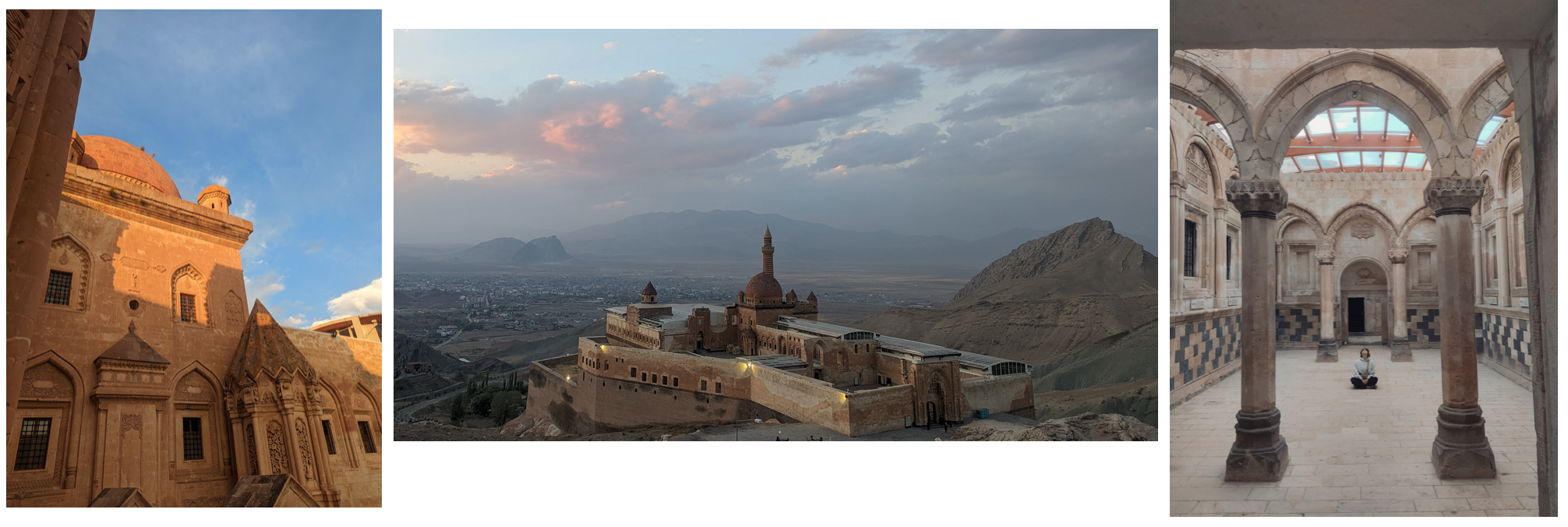
Kars
Like Dogubeyazit, the main site of interest in Kars was actually just outside it. We visited this first: the Ani Ruins. These are the ruins of a medieval Armenian city, and it was huge. Behind a big double wall stood a large, open, hilly field. Scattered around this were remnants of buildings. The field was surrounded by a river, and an empty valley on one side with caves cut into the rock. Armenia was just the other side of the river. The scenery reminded me a lot of Scotland. We spent several hours walking around the entire site, listening to the audioguide. It was crazy to think what it would’ve been like back in the day. One of my highlights was seeing the ruins of the Silk Road bridge, which marked the entrance of the Silk Road into Anatolia. Armenia say that Turkey are neglecting the site intentionally, and I have to agree with this. Compared to the other historical sites we’ve visited, this one had very little information, with the few signs that did exist being so faded and broken they were illegible. Maybe Turkey should just give it back to Armenia…
Kars itself was lovely, a nice middle ground between the modern Van and the pretty Sanliurfa. It had a cool cheese museum (a local delicacy) and a castle (not as cool as the one in Van). I had my one and only disappointing meal in Turkey here, with the traditional goose meat and rice being insanely salty and otherwise tasteless. But we also had a very good meal so I won’t hold it against Kars!
Speciality: Goose meat.

Hopa
The last stop on my Turkey journey was Hopa, a little town right on the Black Sea, and very close to the Georgian border. The drive over was fun, with us ascending up into the mountains. First we saw snow in the fields next to the road, then it started to snow on us, and finally it started to settle on the road. I was driving (I always seemed to get the tricky bits of the journey!) and took it very slowly, with Felix being a very helpful copilot. We followed in the tyre tracks of a big lorry in front of us, thinking if that can make it so can we. Despite the fear factor, it was really beautiful, and as was the rest of the drive inside a gorge and then a very big tunnel. I only spent one evening in Hopa and it was a strange place. It was clearly a truck stop point, illustrated by the huge number of trucks and the multiple seedy nightclubs.
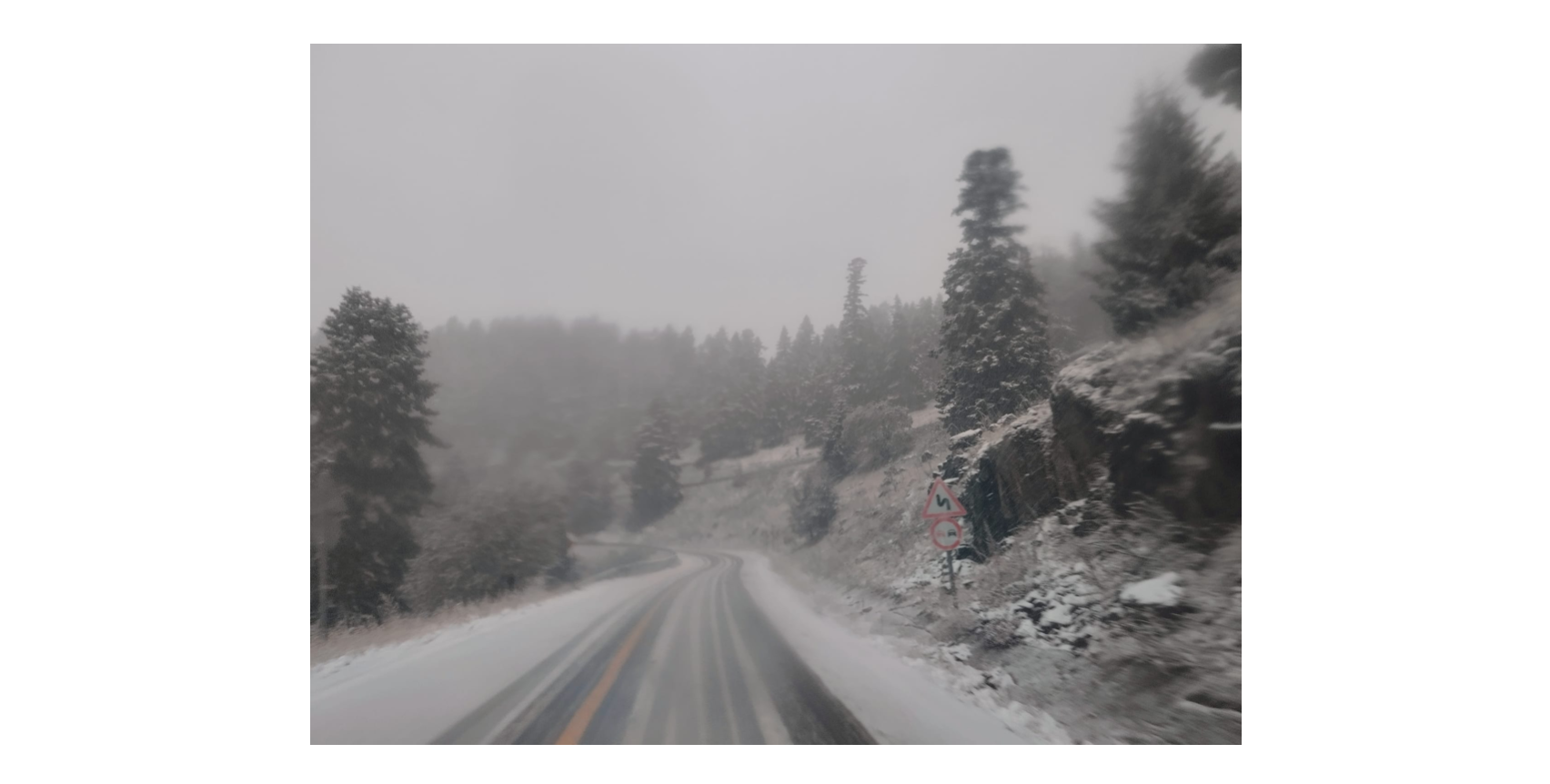
In summary
To sum up Turkey in one sentence: you will be offered tea, and if you refuse you will still be given tea.
I’m actually going to miss the tea, it’s served black and is weaker than British tea, and I really grew to like it. But the fact you’ll be given tea even if you refuse is a good example of the underlying something that I didn’t love about Turkey. Yes the people are wonderfully generous, but sometimes to the extent that it’s forceful and uncomfortable. If my “no” to tea wasn’t listened to or respected, would anything I say be adhered to? The people here are also very nationalistic, but it is illegal to say anything against the current President so I guess that makes sense. I didn’t love that! I got the impression from a lot of younger people that they were desperately jealous of us, travelling around and seeing new places. It gave me hope that in the future this generation will have the opportunity to travel and in turn mellow their conservative views. But perhaps that will also see a mellowing of their intense culture, which is arguably a loss.
Less glamorous parts:
- Having to cover up constantly, despite the searing heat.
- Being desperate for a proper coffee and spending each morning walking far and wide to locate one, often to be left very disappointed. But when we did occasionally find one, like we did on our third day in Mardin, the struggle made it taste even better.
- Some of the military and police checkpoints on the road were a tad scary. Sometimes they would get angry with us for not understanding what they wanted. We were always able to calm to situation down by being extremely polite and friendly. We had one stop that was especially unnerving. On the way from Van to the ferry point for visiting Akdamar Island we were stopped by men in normal clothing, no uniforms, all holding screwdriver like tools. They shouted that they were police but we made sure to ask for ID before we opened the van like they were ordering us to do. They said they were checking for drugs as they poked around inside, with me sat smiling on the bed. They didn’t hold us for long, but we all felt quite shaken by the experience.
- Helena and I would do yoga every morning, always finding somewhere to do it in the hotels without any real problems. In Dogubeyazit, this location was in the corridor just outside of our room. Near the end of my practice the guy that worked there came up to me with a message on google translate reading “can you go back to your room. This is Turkey, they can do anything to you here”. I’m not too sure what he was trying to say to me, but it did shake me a bit.
- In my mission to try as many new foods as possible, some mistakes occur. An especially embarrassing one was in the bazaar in Sanliurfa. We saw brown balls in the mixed nuts barrel that looked like chocolate. I picked one to try, popping it in my mouth and biting down. It was at this point I realised why all of the men were staring at me in shock, it was a hazelnut with its shell on. The bitter taste of an inedible nut shell in my mouth, and the hard shell fragments on my tongue. I spat it out into my hand, joining in with the men who were now openly laughing at me. (See photo below.)
- Late buses… (See photo below for how happy this makes me.)
